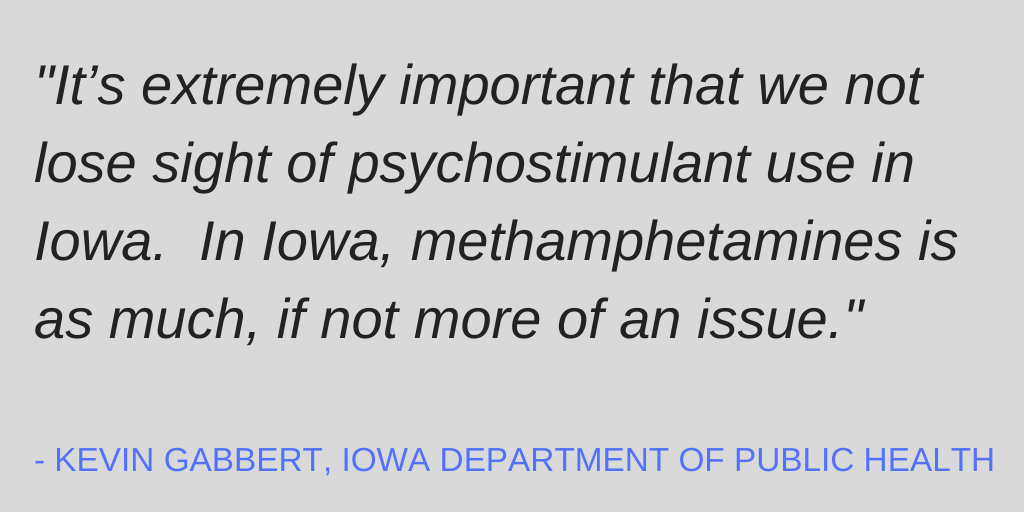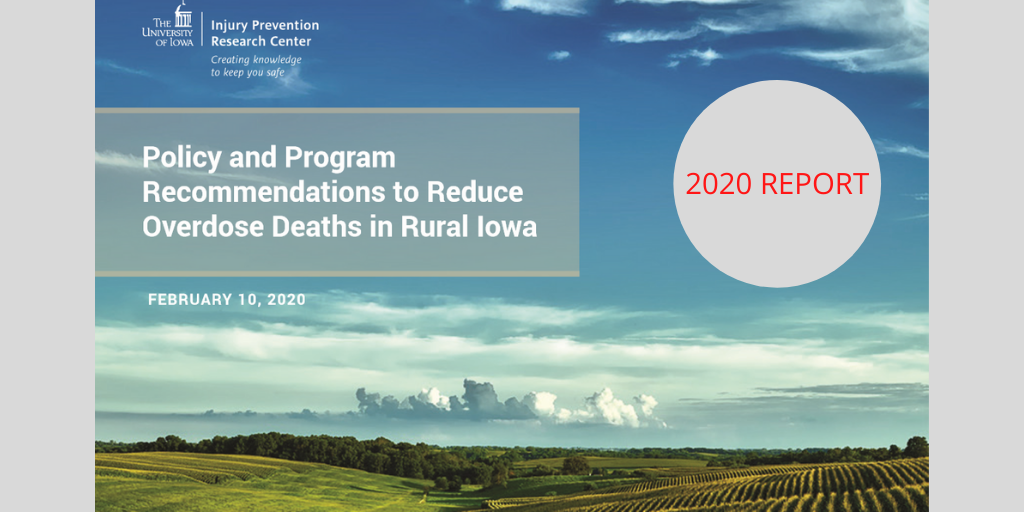At the start of the COVID-19 pandemic, KC*, a man from Northeast Iowa, had been taking the medication buprenorphine (Suboxone) for eight months to treat his opioid use disorder. When he started working remotely at home and his life became increasingly unstructured, he stopped the medication and began using heroin again. He was bored, lonely and stressed out, and figured getting high would not affect his job performance since he no longer had to get up early to work.
However, the heroin seemed different to him and did not sustain his high, so he increased his use: At the end of March 2020, he overdosed for the first time and was revived with naloxone (Narcan), a life-saving opioid overdose reversal medication. [*name changed for privacy]
According to the CDC, the highest number of overdose deaths ever recorded in a 12-month period in the U.S. (over 81,000) happened in the 12 months ending in May 2020. The CDC data suggests overdose deaths were already increasing in the months before COVID-19 and accelerated during the pandemic. Synthetic opioids (primarily illicitly manufactured fentanyl) were the main driver of the increases in these deaths.
Kevin Gabbert, Opioid Initiatives Director at the Iowa Department of Public Health (IDPH), said Iowa, like many states, has seen an increase in the number of deaths related to opioids prior to COVID-19 (2019) and that number continued to increase in 2020.
“We can’t say with certainty whether COVID-19 has caused the increase we’re seeing in deaths related to opioids,” he said. “We think there are several possible reasons why we’re seeing an increase, many of which could have been magnified by the COVID-19 pandemic. These include isolation, reduced access to care, potency/toxicity of drugs, reduced tolerance, and respiratory complications.”

Challenges during COVID-19
Dr. Alison Lynch, Director of the Addiction & Recovery Collaborative and the medication-assisted treatment (MAT) Clinic at the University of Iowa Hospitals & Clinics said the challenges of the opioid epidemic during the pandemic are social isolation, the continued and seemingly worse contamination of the drug supply with fentanyl, and stressors such as job loss, financial stress, and grieving loved ones.
“One of the lessons of the pandemic is that human interactions are absolutely critical for our health and well-being. And they are especially important for someone who is in recovery from substance use,” she said. “Going to meetings, connecting with a sponsor, spending time with family or friends, seeking input from a pastor, working with a peer recovery support specialist, and absorbing the wisdom of a person with lived experience are all ways that people rely on social connections to strengthen their recovery.”
Social distancing is one of the strategies used to reduce spread of the coronavirus. However, Gabbert said, “For some, this can be especially concerning for those using substances like opioids. While using substances alone can be indicative of the later stages of a substance use disorder, with the varying potency we’re seeing due to synthetic versions of opioids, using alone means not having the benefit of others around them that may notice symptoms of a possible overdose.”

Sarah Ziegenhorn is a medical student at the University of Iowa who founded the Iowa Harm Reduction Coalition and later lost her partner in 2019 to an opioid overdose.
She said, “To survive an overdose, it’s crucial that a person overdosing is either using drugs in the company of other people or is found by someone who can either call 911 or administer naloxone themselves.”
Ziegenhorn said disruptions in the supply chain for heroin and methamphetamine in the U.S. may play an even greater role in the rise of overdose deaths than the emotional pain, isolation, and financial insecurity tied to the pandemic.
“Throughout the first few months of the pandemic, clients reported that it was almost impossible to purchase meth in Iowa,” she said. “People also regularly reported purchasing heroin that seemingly contained little to no heroin. Some guessed that they were purchasing a mixture of mostly fentanyl and a benzodiazepine, which carries a greater risk for overdose than using either one of the drugs alone.”
Another risk COVID-19 poses to individuals with an opioid use disorder has to do with how the virus can significantly impact breathing, Gabbert said. The primary cause of death for individuals that experience an opioid overdose is respiratory depression.
“If an individual that has COVID-19 uses opioids, there’s the possibility that the two issues combined could cause additional risks,” he said.

Telehealth during COVID-19
Monica Wilke-Brown, who directs state opioid response projects at the Iowa Department of Public Health (IDPH), said the use of telehealth, or receiving health care via videoconferencing, has helped Iowans with a substance use disorder continue to get the treatment they need. The IDPH conducted a survey prior to the pandemic, finding 15-20% of Iowa providers used telehealth to provide services. After the coronavirus outbreak, around 85% reported serving clients using telehealth.
She said, “Perhaps the most significant change has been the increased use of telehealth as a form of treatment delivery, benefiting people in both rural and urban communities.”
Lynch said before the pandemic there were many restrictions on telehealth, especially when used to treat an opioid use disorder. Once the pandemic hit, several federal rules were temporarily modified, allowing telehealth services directly to personal electronic devices.
“As important as human interaction is, we have learned we can do more through video than we realized,” she said. “It is more convenient, it can be more confidential, it takes less time, and people can do it from home, so they don’t have to worry about being exposed to the virus. Once the pandemic is over, I hope we will still be able to offer telehealth.”
Ziegenhorn said the influx of patients entering suboxone treatment has not been significant enough at the national level and may reflect the high degree of variation of responses of treatment providers in the U.S. to the pandemic.
“A woman from Southern Iowa had been taking suboxone for one month when the pandemic started. The clinic she went to required daily dosing of suboxone, so she drove one hour each way to pick up her medication. A number of weeks after the rule change, the woman was still driving to the clinic on a daily basis, which became increasingly worrisome as the pandemic worsened in Iowa. When she was denied a request for telehealth visits, she left treatment and returned to regular heroin use,” Ziegenhorn said.
Overdoses in Iowa
In 2018 there were 137 deaths related to opioids in Iowa, which was a significant decline from the previous year (206 deaths in 2017). In 2018 Iowa Governor Kim Reynolds signed legislation primarily addressing prescription opioid use.
Deaths related to opioids increased in 2019 (157 deaths) and again in 2020 (208 deaths), though 2020 data will likely increase as more medical examiner reports are finalized, Wilke-Brown said.
Iowa is seeing a significant increase in both the number of individuals being treated for psychostimulant use (e.g., methamphetamine) and the number of related deaths. In 2019, the number of deaths related to psychostimulants was slightly higher than the number of deaths related to opioids in the state.

Looking forward, Wilke-Brown said Iowa still needs more practitioners trained and receiving a waiver to prescribe buprenorphine, a treatment for opioid use disorder.
“While there has been a significant improvement as we’ve increased from 31 waivered prescribers in 2015 to 196 in 2021, there is still a need for more prescribers, especially in rural parts of the state,” she said.
The UI Injury Prevention Research Center (UI IPRC) published a report ahead of the coronavirus outbreak in the U.S. highlighting recommendations for reducing overdoses. These recommendations were identified by stakeholders across the state representing over a dozen fields.
The top five priorities were 1) develop treatment and recovery programs that take a holistic approach to helping those with substance use disorders (i.e., housing resources, job placement programs); 2) develop timely communication networks between stakeholders; 3) consider polysubstance drug use (using more than one drug at a time) in surveillance efforts; 4) provide funding for naloxone access & distribution; and 5) combat stigma associated with substance use disorders. These priorities were shared with Iowa policy makers and stakeholders across Iowa.
Before the pandemic began, Ziegenhorn said, the overdose crisis was the dominant public health story in the media for many years, but over time lost public and policy maker attention as apathy set in.
“Anecdotally, it’s hard to find anyone who is unfamiliar with the overdose crisis, but it is rare to encounter someone who is aware of the pandemic’s impact on the crisis. This may be a result of COVID-19’s media dominance, but it may also stem from public fatigue with the overdose crisis, which predates the pandemic.”
Ziegenhorn said the drop in media coverage of the overdose crisis may cause elected officials to shift their attention elsewhere. “But with an alarming rise in deaths from 2019 – 2020, it’s hard to think of a worse moment for inattention or inaction.”
Published 3/8/2021
Additional resources:
Syringe services program (SSP) operational changes during the COVID-19 global outbreak
In the shadow of the pandemic, U.S. drug overdose deaths resurge to record
Iowa Harm Reduction Coalition webinar: Medication Assisted Treatment & COVID-19 in Iowa
CDC: Overdose deaths and the involvement of illicit drugs